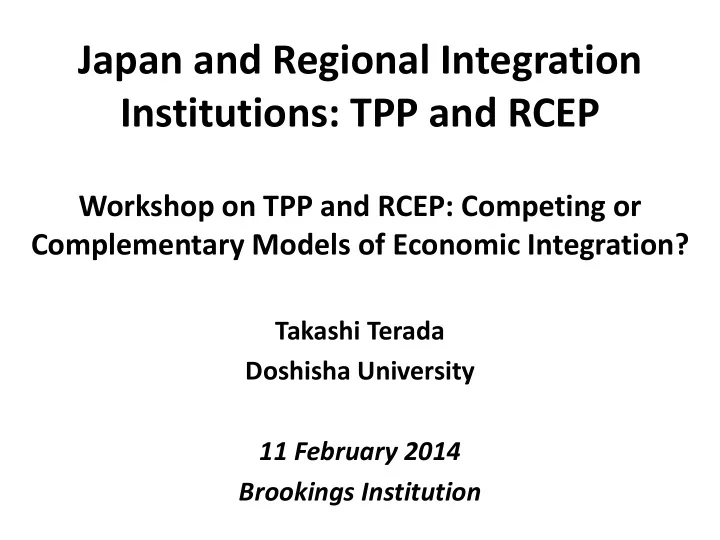

Japan and Regional Integration Institutions: TPP and RCEP Workshop on TPP and RCEP: Competing or Complementary Models of Economic Integration? Takashi Terada Doshisha University 11 February 2014 Brookings Institution
Regional Integration Institutions in Asia and the Pacific (Sep. 13) APEC:FTAAP RCEP Russia ASEAN+3 CJK China Taiwan Korea HK Indonesia ASEAN Philippines Cambodia Thailand NAFTA Laos JAPAN Mexico TPP Myanmar Brunei Canada Malaysia NZ USA Singapore Australia Peru Viet Nam Chile India Papua New Guinea ASEAN+6
TPP (12 states) RCEP (16 states) CJK (3 states) Features 1. US-led & 1) No state-led & 1) China & Korea vs 1) who NAFTA-based: ex) ASEAN-based: any Japan leads environmental & provision is based on 2) Between TPP and labour clauses. conditions/terms of RCEP. 3) Yes. 2) quality 2) deep but ASEAN+1 FTA. and size narrow: US & 2) shallow but wide: Japan dominated: China, India, and 3) 90% of the total Indonesia participate. Flexibility GDP. 3) Yes. 3) Yes/No. Target year April 2014? Late 2015 Not sure 21 8 15 Covered Areas Market Bilateral Multilateral (common JP: multilateral access tariff rates) CH & KR: bilateral Service Negative list Not sure Not sure Single-undertaking Sequential manner, Not sure Negotiating Styles single undertaking or other modality.
TPP’s key feature: bilateral in multilateral 1) Expansion of countries that are the subject of cumulative origin, which has the benefits of increasing the number of goods for which no tariff is applied, simplifying the ROO and contributing to export expansion. Yet, the US did not follow this approach, and the TPP’s market access negotiations have been carried out bilaterally among 12 countries, possibly creating more than 50-60 bilateral agreements, simply confusing MNCs and (greatly) reducing the TPP’s usefulness.
• US-Japan (separate) negotiations, the key for the successful conclusion of 12-country negotiations. Japan is pressured to eliminate agricultural tariffs by the US, especially pork and beef (US products account for nearly 50% in MA foreign rice in Japan while 60% of wheat purchased by Japanese government is made-in-USA). Opening up those markets, based on MFN rule, would make those markets in Japan more competitive.
• ASEAN is divided by TPP; “lowest common denominator” problem in ASEAN, may be affected; but RCEP may keep this practice as a framework an old and traditional approach with the flexibility clause can be employed. • Yet Japan’s interest in RCEP: potential growth of ASEAN economy (economic and technical cooperation agendas have been underscored as a useful approach for helping ASEAN’s integration). *17% of Japanese MNC’s overseas deals in 2013 were made in ASEAN economies, compared with 3% in 2012).
For Japan TPP is: 1) rule-making cutting-edge mechanism : establishing more developed-nation-oriented rules for trade and investment , together with the US. 2) yet, traditional elements persistently remain: bilateral and separated ROOs, and agricultural liberalisation as a dominant agenda. Old issues reduce the attractiveness of new approaches and issues.
For Japan, RCEP is: 1) Market expansion mechanism (traditional) : eliminating higher tariff and non-tariff barriers in its larger trading partners such as China, India and Indonesia. ASEAN centrality will not make its 21 st century agendas feasible. 2) Yet, it has employed multilateral approach, with an intention to make it user-friendly, a merit for companies, expanding regional supply-chain networks.
Recommend
More recommend